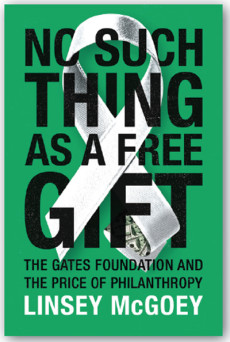
No Such Thing As a Free Gift: The Gates Foundation and the Price of Philanthropy
Linsey McGoey
296 pages, Verso Books, 2015
About halfway through No Such Thing as a Free Gift, her book about the Bill & Melinda Gates Foundation, Linsey McGoey suggests that it’s necessary to review Bill Gates’s tactics at Microsoft Corp. in order to understand his current work as a philanthropist. At Microsoft, she explains, Gates’s managers would blacklist journalists as a means of preventing negative coverage of the company’s business practices. She offers a compelling example: “John Dvorak, a columnist at PC Magazine, describes how Microsoft management would list reporters on a whiteboard with the comments ‘Okay,’ ‘Sketchy,’ or ‘Needs work.’ Many reporters believed, Dvorak writes, that if you ended up in the ‘needs work’ category, Microsoft would take pains to try and have you fired.”
If people at the Gates Foundation follow a similar practice with writers who are critical of the foundation, no doubt they will consider McGoey to be someone who “needs work.” Fortunately for her readers, McGoey doesn’t seem to care. A sociologist at the University of Essex, she brings courage and intellectual depth to the task of confronting the Goliath of the philanthropic world. In No Such Thing as a Free Gift, she delivers a well-documented manifesto not only against the Gates Foundation but also, more broadly, against the movement known as “philanthrocapitalism.” I hope that people at the Gates Foundation, instead of dismissing (or blacklisting) McGoey, will treat her with the respect that she deserves both as a scholar and as an engaged global citizen who has a big stake in the activities of their organization.
For her definition of philanthrocapitalism, McGoey draws from the book Philanthrocapitalism: How the Rich Can Save the World (2008), by Matthew Bishop and Michael Green. Paraphrasing them, she notes that the term has two distinct meanings. First, it involves “a novel way of doing philanthropy, one that emulates the way business is done in the for-profit capitalist world.” Second, it concerns “the way that capitalism itself can be naturally philanthropic.” McGoey focuses on the Gates Foundation because other philanthrocapitalists herald Gates as a leader of the movement. She also argues that the organization’s funding practices warrant more careful scrutiny than they have received so far.
In her book, McGoey aims to do two things: she seeks to place contemporary philanthrocapitalists’ claims to novelty in historical context, and she intends to explore the social consequences of their funding efforts both inside and outside the United States. She finds that present-day philanthrocapitalists have much in common with earlier philanthropists such as Andrew Carnegie and John D. Rockefeller. Like their counterparts today, the industrialists of the late 19th and early 20th centuries made efforts to bring private-sector methods into the philanthropic sector.
Yet McGoey contends that certain attributes of the current cohort of philanthropists are novel. Not only do the philanthropists of our own time act on a wider, more global stage than their predecessors, but they are also more explicit about advancing their own interests. “Philanthropy often opens up markets for US or European-based multinationals which partner with organizations such as the Gates Foundation in order to reach new consumers. Giving more is an avenue for getting more,” McGoey writes.
The book is intended for a broad audience that includes scholars, journalists, and citizens who have an interest in applying a historical and critical lens to philanthrocapitalism. The first few chapters of the book provide an analytical and historical introduction to philanthrocapitalism, and the remaining chapters focus primarily on the Gates Foundation’s grantmaking in the fields of public education and public health. The book concludes with a cutting assessment of the organization’s role in society, and of philanthrocapitalism more broadly.
To inform her analysis, McGoey relies on numerous interviews that she conducted with scholars, journalists, and nonprofit practitioners. She also draws thoughtfully from sources in the history of philanthropy and in the social sciences. Glaringly absent from the book, however, is direct source material from the Gates Foundation. If she had interviewed its staff members or accessed its internal documents, perhaps McGoey would have come to view the foundation as in some ways a flawed and misguided group, and yet in other ways as a well-intentioned one. (Of course, if the foundation didn’t grant McGoey interviews or entry to its archives, she cannot be blamed for failing to offer a more nuanced portrayal of the organization.)
In any event, McGoey has courageously provided readers with a blueprint for analyzing and questioning the significant public role played by philanthrocapitalists in societies across the world today.

